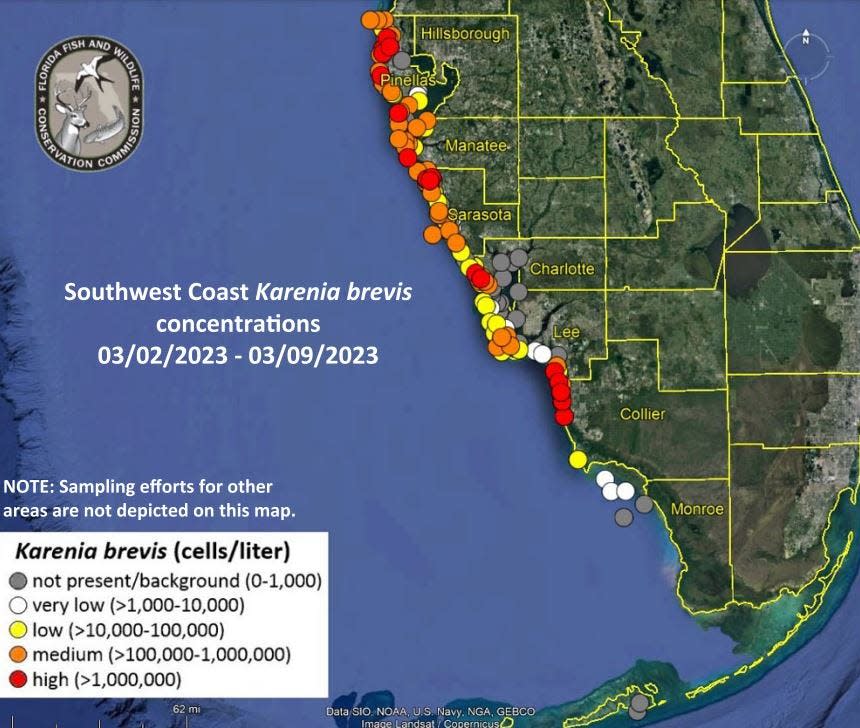What you should know about red tide: And is my spring break going to get ruined?
A red tide bloom is defiling parts of Florida's southwest coast with toxin levels high enough to trigger respiratory alerts and cause widespread fish kills.
Fort Myers Beach removed more than 13 tons of dead fish as of March 10, but high levels of the seafaring algae have been reported from Clearwater to Naples. The red tide can shift quickly based on currents, tides and winds. That means beaches impacted one day, may be clear the next. Although red tides are often dissipated by spring, the heaviest years can see blooms linger through summer and into early fall.
Spring break for Palm Beach County public school students runs March 20-24. Anyone heading to the beach may want to check the Florida Fish and Wildlife Conservation Commission's red tide report for updates on red tide conditions.
Red tide impacting Florida beaches: 6 things you need to know about toxic algae
Assault on Florida beaches: A giant sargassum seaweed blob takes aim at Florida
A background trace of red tide was detected on the east coast. Is red tide in Palm Beach County?

Although a background trace of red tide, which is formally known as the single-cell Karenia brevis, was detected off Juno Beach on the east coast of the state in mid-February, it was not found in subsequent tests as of March 10. No health concerns or red tide-related fish kills have been reported in Palm Beach County.
More:Red tide: You can’t smell it, but here’s what to do if it irritates you
Red tide map: What part of Florida is affected by red tide?
Spring breakers heading to South Florida can check the status of red tide blooms from the Florida Fish and Wildlife Conservation Commission website FWC.com.
While it is rare for harmful red tide blooms to occur on the east coast, it can happen either by naturally growing offshore or traveling from the west coast through the Florida straits and into the Gulf Stream current, which runs closest to Palm Beach County.
More:SPECIAL REPORT: A foul task - cleaning up Florida’s red tide corpses
Is red tide harmful to humans and marine life?
Once in the Gulf Stream, waves can force the toxin produced by the Karenia brevis to be dispersed in the air, which can be carried by east winds to the beaches. When inhaled, the toxin can cause respiratory symptoms in people, such as coughing, wheezing and sore throats. In marine life, it's a killer that affects the nervous system and can cause paralysis.
As of the first week of March, no red tide had been detected in Miami-Dade, Broward and Palm Beach counties.
More:What the red tide samples show — and other questions you may have
Red tide hit Florida beaches hard in 2018
That wasn't the case in 2018 when a devastating bloom of red tide on the west coast persisted through the summer, eventually finding its way to east coast beaches.
Since 1972 when the transport of red tide from the west coast to the east was first identified, seven more instances had been documented prior to 2018, according to the Florida Fish and Wildlife Conservation Commission. Those include in 1990, 1997, 1999 and 2006. In 2007, a red-tide bloom near Jacksonville traveled south with a near-shore current.
More:Why weren't toxic algae health alerts publicized until this month? May was plenty toxic
Since the 2018 outbreak on the east coast, red tide has been detected five times in Palm Beach County in background traces to very low amounts. None resulted in fish kills, health warnings or fish kills.
Red tides are naturally occurring and have been observed in the Gulf of Mexico since the 1800s. Nascent research, however, has linked the exacerbation of red tides at the coast to nutrient-laden runoff from farms and homes.
What exactly is red tide?
It is a sea-faring toxic algae, formally known as the single-cell Karenia brevis.
It produces a toxin as a defense mechanism.
What is the main cause of red tide and how long does it last?
Red tides are naturally occurring. They have been observed in the Gulf of Mexico since the 1800s.
They can grow far offshore in the Gulf and pile up near the coast in the fall and winter as wind patterns blow cold fronts into Florida.
Red tide is often gone by spring, but in some years, the infection has lingered. Nascent studies have connected nutrient-laden runoff from farms and developments to increased levels of red tide along the coast.
Can red tide on Florida's west coast reach the state's east coast?
Yes. A west coast bloom can reach the east coast if it gets caught in the Gulf of Mexico's loop current and travels through the Florida Straits into the Gulf Stream — a north-moving river of warm water that skims the Palm Beach County coastline.
Once in the Gulf Stream, waves can force the toxin produced to be dispersed in the air, which can be carried by east winds to the beaches.
Will they close beaches if red tide reaches Palm Beach County?
The closure of beaches is a local decision by the county and individual municipalities. In many cases, the beaches remain open, although swimming is discouraged. Other times, authorities may close the beach entirely.
Kimberly Miller is a veteran journalist for The Palm Beach Post, part of the USA Today Network of Florida. She covers real estate and how growth affects South Florida's environment. Subscribe to The Dirt for a weekly real estate roundup. If you have news tips, please send them to kmiller@pbpost.com. Help support our local journalism, subscribe today.
This article originally appeared on Palm Beach Post: Red tide in Florida: Status for Spring Break 2023 in Palm Beach County

